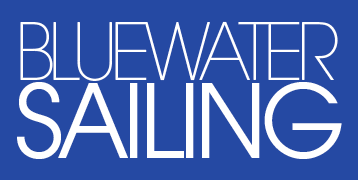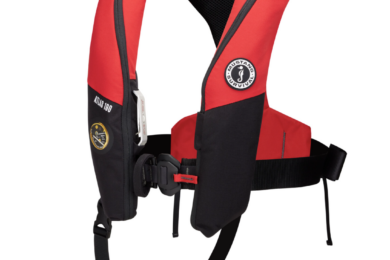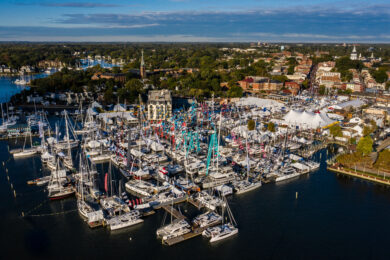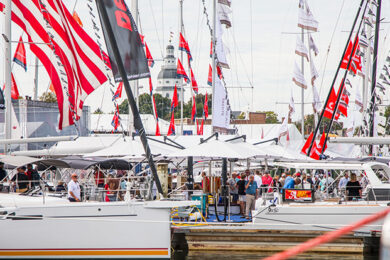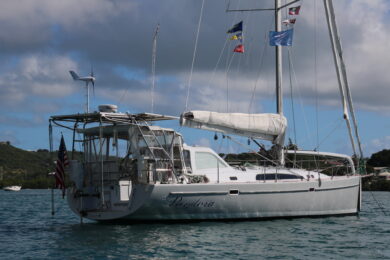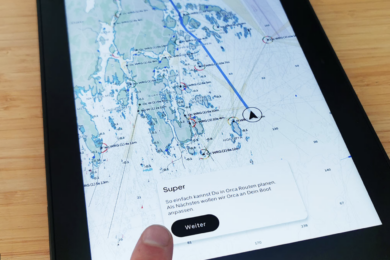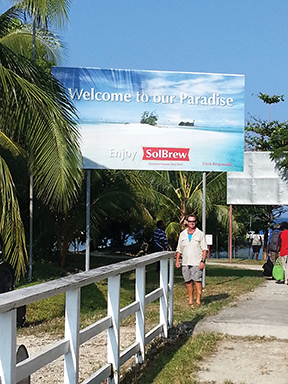We all want to share our onboard adventures with family and friends. Emails, photos and blogs are a great way to stay connected but can often fall short capturing the whole experience. In my opinion the only way to truly give people a slice of life onboard is to invite them to sail with you (published October 2016)
Inviting people into your floating world is exhilarating but it can be daunting as well. Managing personalities, responsibilities and expectations is a delicate task. Choosing when and where to have guests join the boat can make the difference between a memorable holiday and a trip everyone would prefer to forget.
TIMING IS EVERYTHING
One of the most difficult things about having people visit is actually getting them to the boat. It’s true that transportation to some sailing destinations can be challenging and expensive, but often just finding a mutual time in everyone’s schedule can seem impossible. Constrained by work, school and seasonal flight prices our friends and family back home are used to planning vacations several months in advance. However, dates on many cruising calendars are mere suggestions. Our schedules are more likely dictated by seasonal sailing routes, weather windows and boat maintenance.
When flights are booked and a deadline is looming many sailors put to sea in less than favorable conditions, rushing to make port before their guests. This frenzied momentum is not only contrary to the laidback lifestyle that everyone is coming to enjoy, it can put you at serious risk of breakages and injury.
To avoid getting boxed into a specific date or location many people recommend letting the guest pick the when OR the where they want to join the boat, but never allow them to control both variables. This will allow you to either already be at the destination they choose or to have ample time to get the boat there.
Another solution is to invite people to visit when you’re planning on spending several weeks sailing a particular island group. This way your guests can plan ahead and book a flight into the major hub airport well in advance. Later on, if you are unable to make it to their destination they can hop on an internal flight and rendezvous with you at an outer island.
SAFETY FIRST
With everyone finally onboard it’s a good idea to give guests a thorough safety briefing. However, bear in mind that bombarding visitors with too much information when they first arrive can be overwhelming, especially if they have limited boating experience. A short how-to explanation about flushing the toilet, lighting the galley stove and general rules of the boat should be covered on the first day. Many yachties like to post written instructions in the head so that no one has to ask embarrassing questions later and, more importantly, a blocked head doesn’t get in the way of a good time. The location of the medical kit and fire extinguishers are also good introductory topics.
After a hearty meal, a good sleep and a chance to decompress a little you can delve into the finer points of life raft deployment and man overboard procedures. Sailing friends will be well versed with standard safety practices; nonetheless they should be familiarized with your vessel and equipment. For non-sailing friends these worst-case scenario topics can be frightening but they are important, so keep the conversation light.
You should have a proper fitting life jacket for everyone onboard and show people where they are stowed and how to use them. Children and infants require special life jackets as well as other safety items to kid proof the boat. Whether your guests bring them or you provide them, details should be ironed out well in advance so nothing is forgotten. If your guests will be onboard for passages they should also be briefed about the safety procedures that you follow at sea, including wearing a tether and moving around on deck.
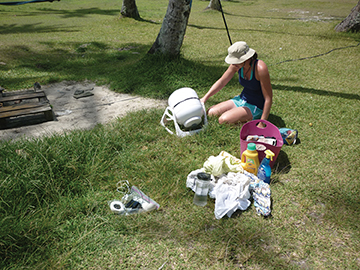
WHAT’S YOUR NORMAL?
Having lived on boats for over a decade I can attest that what is considered normal onboard may not seem quite so normal for those who are just visiting. For instance, many cruisers regularly shower on deck. While the general rule in an anchorage is not to stare while someone is standing on the swim platform lathering up, your guests might not be so comfortable scrubbing their bits in front of an audience. Taking a few minutes to think about your daily routine from an outsider point of view will help you discover any “normal” habits that are worth mentioning before your guests arrive.
Showers can be a contentious issue even if they are a more private affair. Water is a precious commodity on a sailboat—how much you have, how much you use and where can you get more are constant concerns. Not only will extra people onboard tax your water supply, our landlubber friends don’t usually share our appreciation for water conservation. People used to standing under an endless stream of water may not find using a shower bag, rinsing in salt water or turning off the tap between lather and rinse fulfills their idea of clean.
Laundry is another water related issue for guests that stay for more than a week or two as extra bedding, towels and even personal items will need to be laundered. When we had a friend visit in French Polynesia for a month she was happy to help schlep items ashore to hand-wash laundry in unlimited fresh water. This proactive approach may not suit everyone and mentioning your regular routine when it comes to all things water related could eliminate any unwanted surprises.
Power is another precious commodity onboard. The ability to plug in an endless number of electrical appliances and digital devices is something a lot of non-boat people take for granted. Telling visitors about power availability, as well as chargers and adaptors they might need for their devices, could be the difference between enjoying a quiet anchorage and listening to the engine while you charge the batteries.
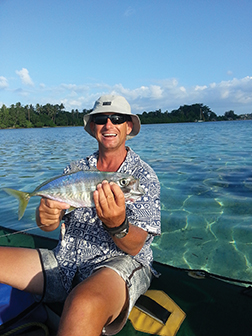
GREAT EXPECTATIONS
Unaddressed expectations are often our worst enemies. Not informing your guests about how you want them to help out or contribute while onboard can leave you feeling like you’re playing tour guide rather than host.
It is best to get financial issues out of the way directly by telling your visitors before they arrive what expenses they will be required to cover. It is routine for people to take care of their own travel costs but if you’re expecting your guests to contribute to the costs of fuel, food or marina fees it would be polite to inform them in advance of what charges to expect.
The same goes for any extra-curricular activities that your guests might enjoy while visiting such as fishing charters, dive trips and equipment rental or sight-seeing tours. Providing some information before arrival will not only allow visitors to budget for such activities but also give them time to obtain local currency.
Asking guests about their expectations will also help you plan an itinerary for their time onboard. Do they want to spend time in more secluded locations? Do they prefer to be in a marina or near a resort where there are activities ashore? Are they iced-filled cocktails all afternoon type of people, or do they want to put some miles under the keel on longer passages? Do they need reliable internet access to stay in contact with work, or are they coming to visit to completely unplug? Asking a few poignant questions will help you map out a schedule, however it should be understood that the itinerary is not set in stone. There are many variables that can alter sailing plans, the most common of which is weather.
Non-sailing guests may not realize how much the weather affects life onboard. From making an anchorage untenable to making passages possible, sailors depend on and respect the weather. Waking up to driving rain or having days of windless conditions are things that cruisers consider disappointments but not deal breakers. Your guests, on the other hand, may not react so calmly to having their tropical vacation rained out. Keeping a positive attitude and being willing to compromise during such occasions is paramount because as we all know, no one controls Mother Nature.
Including visitors in activities such as meal prep and boat handling is a wonderful way to get them involved in life onboard. Incorporating them into everyday tasks will both make them feel at home and take a little pressure off the regular crew. If you insist your guests sit back, put their feet up and relax then don’t be surprised when they do. And be careful, it is easy to resent people having a good time on their vacation when you are stuck in the galley.
HOW LONG IS TOO LONG?
Everyone has a different opinion about how long guests can stay before they wear out their welcome. Many people say that one week is the perfect visit, others think that two weeks is just long enough to get used to the rhythm of life onboard. I think who you invite and where you are sailing are important factors in determining how long you ask people to visit. We’ve had various friends stay for two nights, 10 days and one month. I won’t say that every moment of each trip was a success, but we are still on speaking terms with everyone and we’ve had them come back for repeat visits.
Space is a big issue when considering how long people can stay as extra bodies in a small cabin can make things feel claustrophobic after a few days. Also personal habits and personalities are often magnified at sea, making even loved ones hard to tolerate. And if you ask someone to spend 20 hours flying to your location, you might want to swallow your irritation and let them stay a few extra days. Having guests onboard is about finding a balance between too much and not enough, and only you can determine what tips your scales.
Clear communication, respect for others, keeping an open mind and being flexible are all keys to having a great trip. As the old saying goes, “It is the host’s job to make a guest feel at home, and it is the guest’s job to remember that they are not.”
Heather Francis is from Nova Scotia, Canada and for over a decade has worked and lived on boats throughout the world. In 2008 she and Steve, her Aussie partner, bought Kate, a Newport 41’, and have been sailing ever since. They are planning to do a lap around the planet, albeit slowly. To follow their adventures log onto www.yachtkate.com.
GUIDELINES FOR GUESTS
- Choose soft-sided luggage that folds flat for easy onboard storage
- Swimwear is suitable on the swim platform but may not be acceptable ashore. Ask your hosts about cultural dress codes in the area you’ll be sailing.
- Be proactive. Researching your destination and asking questions before you arrive will ensure you get the most out of your time onboard.
